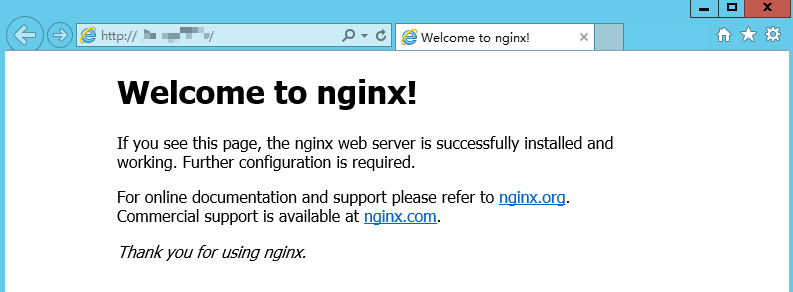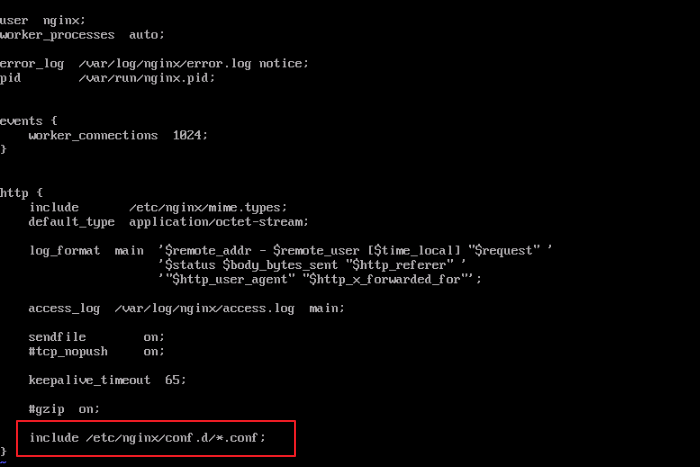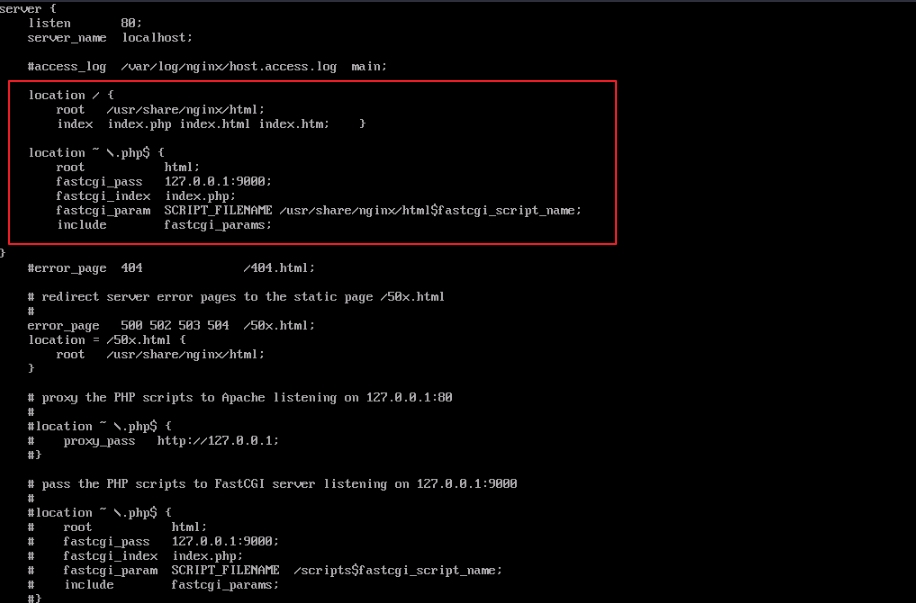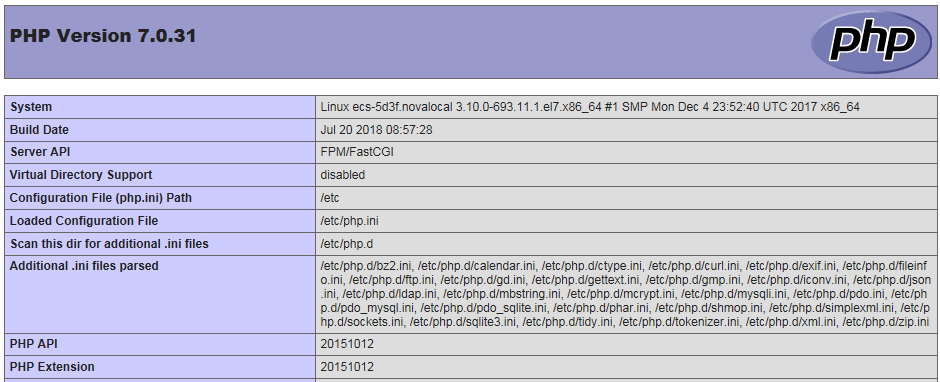手工搭建LNMP环境(CentOS7.2 PHP7.0)
简介
本文主要介绍了在华为云上如何使用弹性云服务器的Linux实例手工搭建LNMP平台的web环境。该指导具体操作以CentOS 7.2 64位操作系统为例。
前提条件
- 弹性云服务器已绑定弹性公网IP。
- 弹性云服务器所在安全组添加了如下表所示的安全组规则,具体步骤参见为安全组添加安全组规则。
表1 安全组规则 方向
协议/应用
端口/范围
源地址
入方向
HTTP(80)
80
0.0.0.0/0
- 为了更好的获取和更新系统和软件,建议您更新镜像源为华为云镜像源,详细操作,请参见如何使用自动化工具配置华为云镜像源(x86_64和ARM)?。
资源规划
本次实践所用的资源配置及软件版本如表2中所示。当您使用不同的硬件规格或软件版本时,本指导中的命令及参数可能会发生改变,需要您根据实际情况进行调整。
资源 |
资源说明 |
成本说明 |
|---|---|---|
弹性云服务器 |
|
ECS涉及以下几项费用:
具体的计费方式及标准请参考计费模式概述。 |
Nginx |
是一个高性能的HTTP和反向代理web服务器。 获取方式: http://nginx.org/packages/centos/7/noarch/RPMS/nginx-release-centos-7-0.el7.ngx.noarch.rpm |
免费 |
MySQL |
是一款开源的关系数据库软件。 获取方式: http://dev.mysql.com/get/mysql57-community-release-el7-10.noarch.rpm |
免费 |
PHP |
是一款开源软件,用于Web开发。 获取方式: |
免费 |
操作步骤
- 安装nginx。
- 安装MySQL。
- 依次执行以下命令,安装MySQL。
wget -i -c http://dev.mysql.com/get/mysql57-community-release-el7-10.noarch.rpm
yum -y install mysql57-community-release-el7-10.noarch.rpm
yum -y install mysql-community-server --nogpgcheck
- 依次执行以下命令,启动MySQL服务并设置开机自启动。
systemctl enable mysqld
- 查看MySQL运行状态。
systemctl status mysqld.service
[root@ecs-adc3 ~]# systemctl status mysqld.service ● mysqld.service - MySQL Server Loaded: loaded (/usr/lib/systemd/system/mysqld.service; enabled; vendor preset: disabled) Active: active (running) since Mon 2021-08-16 19:33:40 CST; 36s ago Docs: man:mysqld(8) http://dev.mysql.com/doc/refman/en/using-systemd.html Main PID: 7916 (mysqld) CGroup: /system.slice/mysqld.service └─7916 /usr/sbin/mysqld --daemonize --pid-file=/var/run/mysqld/mysqld.pid Aug 16 19:33:35 ecs-adc3 systemd[1]: Starting MySQL Server... Aug 16 19:33:40 ecs-adc3 systemd[1]: Started MySQL Server. - 执行以下命令,获取安装MySQL时自动设置的root用户密码。
grep 'temporary password' /var/log/mysqld.log
回显如下类似信息。2018-08-29T07:27:37.541944Z 1 [Note] A temporary password is generated for root@localhost: 2YY?3uHUA?Ys
- 执行以下命令,并按照回显提示信息进行操作,加固MySQL。
Securing the MySQL server deployment. Enter password for user root: #输入上一步骤中获取的安装MySQL时自动设置的root用户密码 The existing password for the user account root has expired. Please set a new password. New password: #设置新的root用户密码 Re-enter new password: #再次输入密码 The 'validate_password' plugin is installed on the server. The subsequent steps will run with the existing configuration of the plugin. Using existing password for root. Estimated strength of the password: 100 Change the password for root ? ((Press y|Y for Yes, any other key for No) : N #是否更改root用户密码,输入N ... skipping. By default, a MySQL installation has an anonymous user, allowing anyone to log into MySQL without having to have a user account created for them. This is intended only for testing, and to make the installation go a bit smoother. You should remove them before moving into a production environment. Remove anonymous users? (Press y|Y for Yes, any other key for No) : Y #是否删除匿名用户,输入Y Success. Normally, root should only be allowed to connect from 'localhost'. This ensures that someone cannot guess at the root password from the network. Disallow root login remotely? (Press y|Y for Yes, any other key for No) : Y #禁止root远程登录,输入Y Success. By default, MySQL comes with a database named 'test' that anyone can access. This is also intended only for testing, and should be removed before moving into a production environment. Remove test database and access to it? (Press y|Y for Yes, any other key for No) : Y #是否删除test库和对它的访问权限,输入Y - Dropping test database... Success. - Removing privileges on test database... Success. Reloading the privilege tables will ensure that all changes made so far will take effect immediately. Reload privilege tables now? (Press y|Y for Yes, any other key for No) : Y #是否重新加载授权表,输入Y Success. All done!
- 依次执行以下命令,安装MySQL。
- 安装PHP。
- 依次执行以下命令,安装PHP 7和一些所需的PHP扩展。
rpm -Uvh https://mirror.webtatic.com/yum/el7/epel-release.rpm
rpm -Uvh https://mirror.webtatic.com/yum/el7/webtatic-release.rpm
yum -y install php70w-tidy php70w-common php70w-devel php70w-pdo php70w-mysql php70w-gd php70w-ldap php70w-mbstring php70w-mcrypt php70w-fpm
- 执行以下命令,验证PHP的安装版本。
回显如下类似信息:
PHP 7.0.31 (cli) (built: Jul 20 2018 08:55:22) ( NTS ) Copyright (c) 1997-2017 The PHP Group Zend Engine v3.0.0, Copyright (c) 1998-2017 Zend Technologies
- 执行以下命令,启动PHP服务并设置开机自启动。
systemctl enable php-fpm
- 修改Nginx配置文件以支持PHP。
- 执行以下命令打开配置文件/etc/nginx/nginx.conf。
从nginx.conf可以看出,配置文件定向至/etc/nginx/conf.d/*.conf。
- 输入:quit退出nginx.conf。
- 执行以下命令打开配置文件/etc/nginx/conf.d/default.conf。
- 按i键进入编辑模式。
- 修改打开的“default.conf”文件。
找到server段落,修改或添加下列配置信息。
server { listen 80; server_name localhost; #access_log /var/log/nginx/host.access.log main; location / { root /usr/share/nginx/html; index index.php index.html index.htm; } location ~ \.php$ { root html; fastcgi_pass 127.0.0.1:9000; fastcgi_index index.php; fastcgi_param SCRIPT_FILENAME /usr/share/nginx/html$fastcgi_script_name; include fastcgi_params; } }如图3所示:
- 按Esc键退出编辑模式,并输入:wq保存后退出。
- 执行以下命令打开配置文件/etc/nginx/nginx.conf。
- 执行以下命令,重新载入nginx的配置文件。
- 依次执行以下命令,安装PHP 7和一些所需的PHP扩展。
- 浏览器访问测试。













